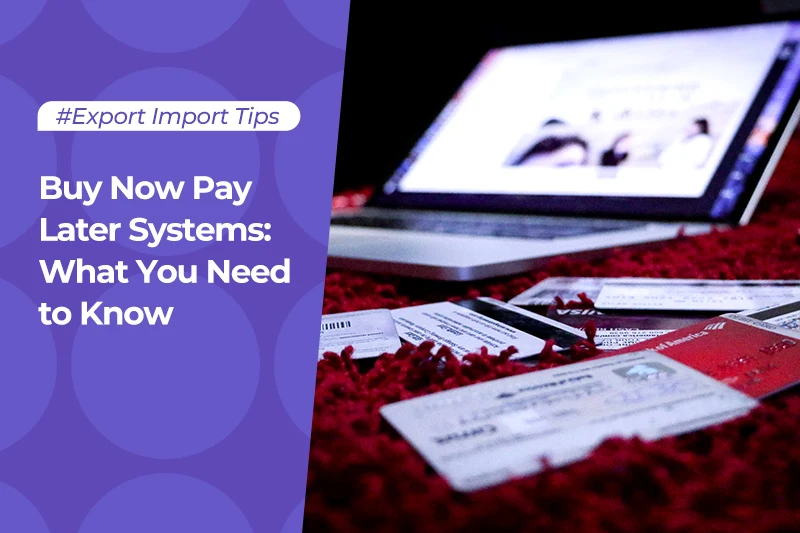Digital B2B Outlook for Germany in 2023

Since the pandemic, the world economy has been threatened by several challenges, and the fourth-largest economy in the world is not left out.
The German economy has been facing weaker growth amidst growing energy concerns, high inflation, and weak demand for the country’s exports. Several German economic institutes reviewed their GDP forecast for 2023 downwards as they anticipate a recession mainly due to the rising energy prices.
Despite the economic downturn, experts forecast that e-commerce will continue to grow and evolve. According to data by ecommerceDB, Germany is the fifth-largest e-commerce market with US$109.1 billion in sales and a projected compound annual growth rate of 9.8% through 2025.1
In this article, we take a closer look at the German economy, discussing the economic outlook for 2023. We also highlight export opportunities for businesses in Germany and the major German exports for 2023.
Table of Contents
Overview of the German economy
Germany’s economy is characterized by highly developed industries, a high export quota, an open economy, high-performing medium-sized enterprises, international trade fair location, strong economic centers, and a quality labor force.
The export-oriented country has a solid reputation for innovation and global competitiveness and is currently the world’s biggest exporter of cars. Germany thrives alongside its industries and looks towards a more self-reliant digital economy.
This rapid growth in digital transformation has positively impacted nearly every sector of the economy, including SMEs (Mittelstand), which account for about 99% of all companies.2
The export-focused economy is highly integrated into the global economy and has a degree of openness of 88% (imports plus exports in relation to GDP). Germany’s main trade partner is the United States, accounting for 8.9% of its exports as of 2021.3
Based on 2020 figures, Germany has a strong trade relationship with the rest of the eurozone. Germany’s exports to eurozone countries accounted for 67.1% of its total exports, while imports stood at 65.3%.4
GDP has been increasing steeply from 2020 to 2021. However, experts forecast that GDP will decline in 2023. Forecasts from Statista show a 1.6% GDP growth in 2022, which would fall by 0.3% in 2023 and rise by 1.8% in 2024. Germany’s GDP is rightly influenced by its service sector, contributing a whopping 70% to its overall GDP.5
Cars still top Germany’s exports as it has retained its position as the biggest car exporter in the world by a wide margin. Germany is also a world leader in exporting automotive parts and medicines. Astonishingly, mineral fuels and oils were the fastest growing export at a 65.4% increase.6
Germany also has one of the largest e-commerce markets in Europe. However, there is a need for improved efforts toward innovation. According to McKinsey, fully unlocking growth in e-commerce would be critical to economic development.7
Germany’s economic prospects in 2023
The pandemic, inflation, rising interest rates, and more trade disruptions significantly impacted Germany’s export-based economy. Although the pandemic continues to significantly impact the economy, most of the previous losses have already been made up for. However, the rising level of inflation still threatens GDP growth.
GDP decline, ushering in a possible recession
Government advisors predict a GDP decline of 0.2% for 2023, which is adverse but much less than most experts had anticipated.8
The IMF made a similar GDP projection of a 0.3% decline against its initial 0.8% growth after taking cognizance of rising energy prices and its impact on the German economy come next year.9
Exports fall due to rising energy prices
Germany recorded its first trade deficit in 30 years in May 2022, which experts attribute to the scarcity of cheap energy for production. The major downside is that the bulk of Germany’s export comes from the energy-intensive sector, including the mineral oils sector, which experienced the highest growth in 2021.
In 2023 and 2024, the government plans to enact a gas price brake for consumers and businesses to curb rising energy costs. Germany continues to dedicate more efforts toward improving its export and, eventually, its trade balance.
In addition to being the number-one exporter of cars, the country has been the third-largest exporter of agricultural goods and the number-one exporter of confectionery, cheese, pork, and agricultural technology. Looking at 2023, this trend is expected to continue.
E-commerce gains traction
Despite the economic challenges of the German economy, e-commerce trade has strengthened. Germany has the potential to unlock growth in e-commerce fully. The European country has one of the best-developed logistics infrastructures with a high internet penetration rate. Germany presents a good opportunity for e-commerce trade, especially B2B e-commerce, since 99% of all businesses fall under the small and medium enterprise range.10
More of Germany’s Brick and Mortar businesses are exploring e-commerce to increase their customer base. Integration of advanced technologies such as live tracking and AI is also expected to increase even more, in tandem with the 2023 e-commerce trends published by Forbes.11
Increased internet inclusion and adoption of e-commerce business models in Germany also paved the way for higher competition. The primary reason is that the barrier to entry has been brought much lower by e-commerce.
The competitive pressures are expected to increase in 2023, and manufacturers and businesses must seek ways to innovate and increase their competitive edge. This digitization of sales is also bound to affect the intermediaries and distribution network, leveling the playing field for market participants.
As the rise in e-commerce continues, privacy concerns grow, but Germany is already at the forefront of maintaining user privacy. Germany was one of the first EU countries to introduce the General Data Protection Regulation (GDPR) in 2018 and continues to implement measures to deter the breach of any provisions of this regulation. This will also contribute toward boosting the credibility of German sellers in e-commerce.
Third-party logistics (3PL) also immensely contributes to the efficiency and growth of e-commerce in Germany and is expected to continue to do so. A report by BusinessWire reveals that 3PL will grow by an accelerating 5% from 2022-2026. It is also expected that a growing investment in sustainability will lead to sizable demand in the e-commerce market.12
Exporting opportunities for Germany
Germany has long had an export-based economy, with a focus on using innovation and global competitiveness to raise both the quantity and quality of its exports while also growing export earnings. Through various exporting opportunities and programs, the German government shows its support for German companies that export. The following are some of these opportunities that German companies can seize:
- Export credit guarantees
Export credit guarantees protect exporters against the risk of unpaid claims in foreign transactions. The federal government takes on a large share of the risk of a payment default. These export credits are available to all German exporters, including the banks that finance these exports.
Export credit guarantees provide additional cover, particularly to SMEs where the private insurance cover is insufficient if a credit risk materializes. Export credit guarantees allow SMEs to continue to do business and tap hard-to-access markets even during difficult times. In 2020, 16.7 billion worth of exports was covered by the Federal Government’s export credit guarantees.13
- B2B e-commerce
German businesses are turning to e-commerce as a way to expand their market and enter new markets as disruptions in local trade and foreign trade partners threaten the revenues and profits of businesses, particularly SMEs.
Germany possesses a highly educated and wealthy population, a major prerequisite for the success of e-commerce. Many brick-and-mortar stores are still in the process of entering the e-commerce space. This is a huge opportunity for businesses looking to expand their market share and overcome the challenges posed by the recent trade disruptions.
- Promotion of foreign trade and investment
Germany’s foreign trade and investment have been a major driver of economic success over the past years. German institutions such as the German Missions Abroad, German Trade and Investment, and the German Chambers of Commerce Abroad work closely to deliver the best possible backing for German firms to promote the activities of them abroad.
- Buy Now Pay Later (BNPL) offerings
Research by Oxford Business Group revealed that BNPL is one of the fastest-growing e-commerce models. According to global data, BNPL accounted for $2 for every $100 spent on e-commerce.14
BNPL is slowly gaining traction in the German e-commerce space, creating new opportunities for sellers. Innovative German businesses can differentiate themselves and become even more competitive in 2023 by introducing BNPL offerings which are gaining traction amongst German consumers.
- Omni-channel commerce
Omni-channel is a cross-channel strategy that unlocks the power of connected customers for businesses in Germany to increase sales reach and improve brand image. Despite the global economic uncertainties and challenges, German retailers and sellers who use omni-channel commerce have recorded resounding success as they can easily meet consumers’ need for convenience and flexibility.
5 German exports that’ll benefit in 2023
Germany is well known for its high-quality exports ranging from machines to chemicals and food products. One reason for its success is its heavy investment in research and development, as well as innovations in areas such as artificial intelligence. Here are the top 5 German exports that are expected to benefit in 2023.
1. Vehicles
Germany is known for its high-end luxury cars and automakers, such as BMW and Mercedes-Benz. This sector seems to benefit even more in 2023 with the introduction of electric vehicles and increased demand for German cars overseas. German auto lobby VDIK told Reuters that they anticipate a 6% increase in sales for the country's auto industry in 2023. Sales of electric vehicles are anticipated to rise by 9%.15
2. Pharmaceuticals
Germany’s large pharmaceutical industry is expected to grow even more in 2023. The country exports a variety of medicines, such as antibiotics and vaccines, at a high rate, and this should continue throughout the year. According to experts’ predictions, the industry will expand by more than 2% in 2023, and they foresee a post-COVID recovery.16
3. Machinery
Germany is a major exporter of machineries such as engine components, construction equipment, and agricultural machinery. The European country has 16% share of the global machinery trade. This sector seems to benefit even more in 2023 with increased investment from global companies. Resource from Germany Trade and Invest (GTAI) revealed an expected 7.65% turnover growth in Germany’s robust machinery and equipment sector 2023.17
4. Processed food
Germany exports a wide range of food products, such as beer, cheese and sausages, which are highly sought after by customers worldwide. The GTAI revealed that one third of processed food produced in Germany are exported. This sector will likely experience an increase in demand in 2023 due to rising international demand for these products. Statistica forecasts a growth of 4.59%.18
5. Other furniture
The other furniture market segment represents furniture accessories such as rugs, hand dryers, table linen, baby cot, and toilet paper holders. Germany exports a wide range of these items which are highly sought after worldwide. With an expected revenue growth of 14.9% in 2023, this sector is set to benefit greatly next year19.
Sell on Alibaba.com
Alibaba.com’s B2B marketplace offers German manufacturers and suppliers a vast sales channel to market and distributes their products regardless of the present trade disruptions. Alibaba.com presently has more than 40 million active buyers from all over the world.
The global B2B e-commerce marketplace offers a seamless transition to B2B e-commerce for traditional stores with features in place to give businesses a competitive edge. All you need to do to start is open a seller account.
References
1. >https://ecommercedb.com/markets/de/all
2. https://www.bmwk.de/Redaktion/EN/Dossier/sme-policy.html
3. https://www.theglobaleconomy.com/rankings/trade_openness/
4. https://santandertrade.com/en/portal/analyse-markets/germany/foreign-trade-in-figures
5. https://www.statista.com/statistics/1322391/gdp-development-forecast-germany/
6. https://www.worldstopexports.com/germanys-top-10-exports/
7. https://www.mckinsey.com/industries/consumer-packaged-goods/our-insights/resetting-the-e-commerce-model-to-achieve-profitable-growth-in-europe#0
8. https://businessworld.in/amp/article/German-Economy-To-Contract-0-2-By-2023-Economic-Advisers/10-11-2022-453557
9. https://amp.dw.com/en/imf-says-germany-and-italy-to-slip-into-recession-in-2023/a-63405441
10. https://www.bmwk.de/Redaktion/EN/Dossier/sme-policy.html
11. https://www.forbes.com/advisor/business/2023-ecommerce-trends/
12. https://www.businesswire.com/news/home/20220706005493/en/German-3PL-Market-Report-2022-2026-E-Commerce-Industry-and-the-Rising-Adoption-of-Omnichannel-Retail---ResearchAndMarkets.com
13. https://www.bmwk.de/Redaktion/EN/Dossier/promotion-of-foreign-trade-and-investment.html
14. https://oxfordbusinessgroup.com/news/can-buy-now-pay-later-model-unlock-e-commerce-potential-emerging-markets
15. https://www.reuters.com/business/autos-transportation/german-car-lobby-vdik-expects-6-sales-growth-german-car-market-2023-2022-12-02/
16. https://group.atradius.com/publications/industry-trends/pharmaceuticals-industry-trends-germany-2022.html
17. https://www.gtai.de/resource/blob/2514/dd936d01d72d8b6118e306137eb15781/Machinery_Equipment_Germany_Industry_Overview_2022.pdf
18. https://www.statista.com/outlook/cmo/food/germany
19. https://www.statista.com/outlook/dmo/ecommerce/furniture/other-furniture/germany
Start your borderless business here
Tell us about your business and stay connected.
Keep up with the latest from Alibaba.com?
Subscribe to us, get free e-commerce tips, inspiration, and resources delivered directly to your inbox.














